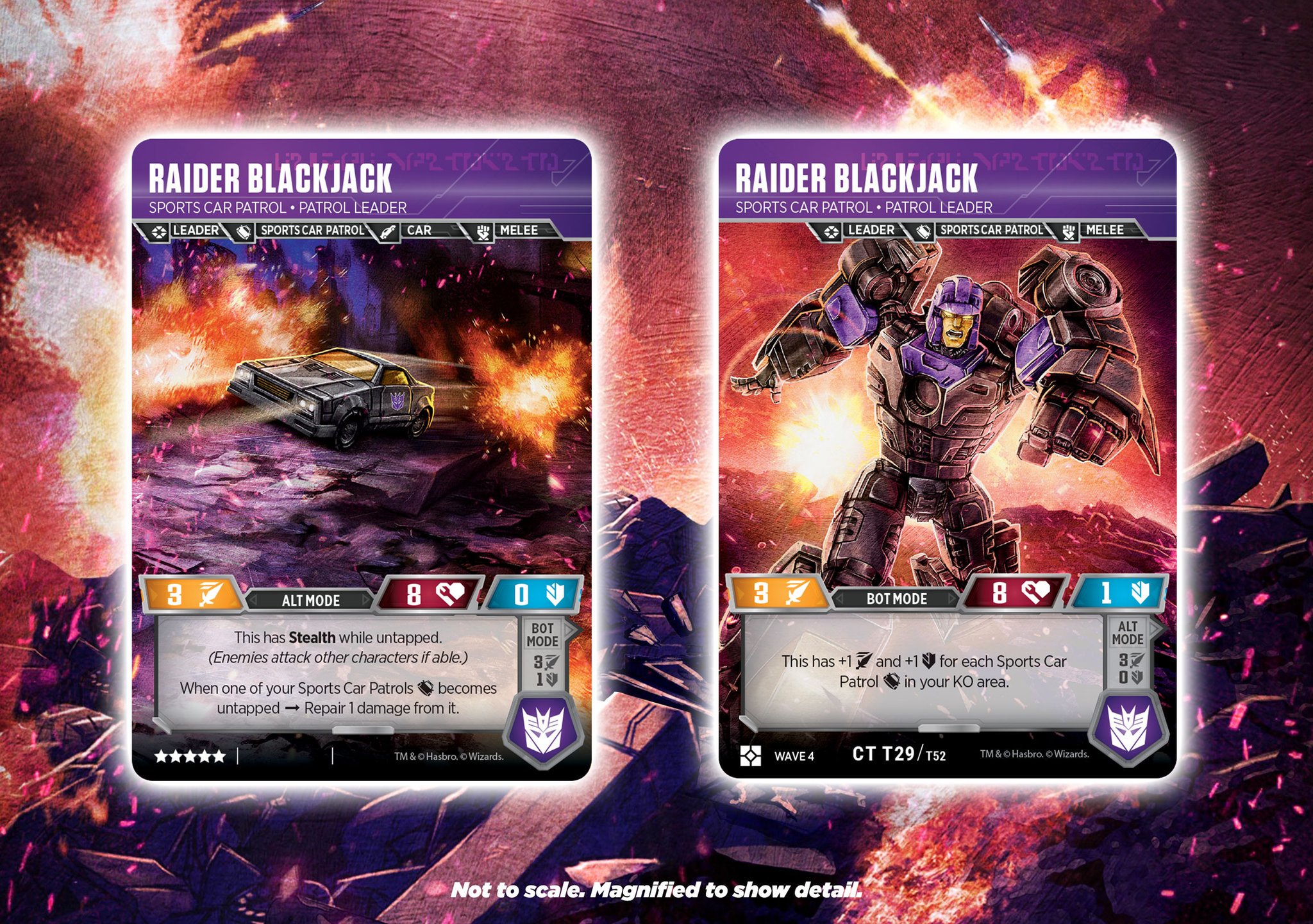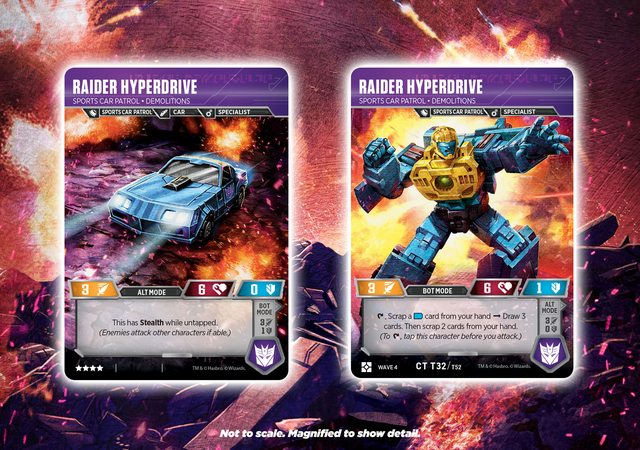"Written by an understudy, yes? Enjoyed, as the thought of crushing tiny patrol insects brings a tear of joy."
Micromasters (Part 1)
2019.10.10
On November the 8th, Wave 4 of the Transformers TCG (TTCG) will be released. One of themes of this fourth wave of cards will be the completion of the Micromaster teams. As most of the new cards have been teased/spoiled, we can start to think about those future Micromaster decks.
The story thus far…
Wave 3, released in June 2019, provided us with 5 Micromaster Patrol teams of 2 transformer bots each, with one 4-star bot and one 5-star bot. These bots introduced a new concept (for TTCG) of a tap-ability, which provided another way whereby the player can apply an effect to the game (other ways would be flipping a bot or playing an action/upgrade card). The bots were good small-bot filler to your team, but it would be unusual, in Wave 3, to build a team focused on Micromasters themselves.
Note that there was also Spy Patrol, but as that’s intrinsically linked with Soundwave I’m going to consider that a different topic.
Wave 4 changes this…
The Wave 4 spoilers have shown us that we’ll get 5 full Micromaster teams, and they’ve shown us the structure of those teams. Here’s the list of bots in each team (note that Seawatch is a guess as they’ve not been spoiled at the time of writing).
The Autobot Micromasters:
- Off Road Patrol: (Highjump, Mudslinger, Powertrain, and Tote)
- Rescue Patrol: (Seawatch, Stakeout, Fixit, and Red Hot)
- Battle Patrol: (Top Shot, Sidetrack, Sunrunner, and Flak)
and the Decepticon:
- Air Strike Patrol: (Nightflight, Storm Cloud, Visper, and Tailwind)
- Sports Car Patrol: (Detour, Blackjack, Hyperdrive, and Road Hugger)
Team Structure
Each of the Micromaster teams is built around a particular color of battle card pip (which may explain why the 6th Micromaster patrol, the Race Car Patrol, have not been seen yet within the TTCG universe; or perhaps they’re shy).
- Off Road Patrol: Black pips.
- Rescue Patrol: White pips.
- Battle Patrol: Orange pips.
- Air Strike Patrol: Green pips.
- Sports Car Patrol: Blue pips.
Each of the teams also has a new member who enhances, and then seeks vengeance for, those around them. If the team did not have a Leader-type published in Wave 3 then this bot is also a Leader-type, but as some of the patrols had a Leader-type in Wave 3 (Top Shot + Visper), I’ll refer to this as the ‘effective leader’.
In their alt-mode, the effective leader provides a patrol-feature to all members of the patrol, including themselves. In bot-mode, the effective leader gains an extra +1/+1 for each team member who is in the K.O. area. This would appear to encourage the effective leader being protected early on in the game, and then attempting some heavy hits towards the end to get their vengeance for their downed comrades.
Lastly, each of the teams has an 18-star count, with two 4-star bots, and two 5-star bots. The effective leader is always a 5-star bot. This means that a full complement of Micromasters is still needing another bot of up to 7-stars to partner with them.
5-wide decks
A full complement of Micromasters, with the addition of a partner bot, should lead to a lot more 5-wide decks being played. Up until now that has primarily been the province of the 5-star combiners (Aerialbots, Stunticons, Predacons), and the 6-wide, 4-star Constructicons. Given that these decks have a sting in their tail (namely the skyscraper smashing big final bot), the Micromaster decks will need to impress with their stings if they’re going to compete.
4-wide decks
An alternative option is to only play with three members of a Micromaster team, allowing for an 11-star or 12-star partner, depending on whether you drop a 4-star or 5-star Micromaster. Given the increased staying power of an 11/12-star bot over a 5/6/7-star bot, and the likelihood that one member of the Micromaster team may be a bit of a runt, this seems a fairly likely evolution for Micromaster teams.
Another reason to consider a 4-wide deck is that it seems unlikely your opponent will want your effective leader to be the last of your Micromasters left alive. While each of your Micromasters have stealth in alt-mode, it may still be unusual to pull off a full +3/+3 vengeance hit.
Tapping vs Attacking
It’s easy to think of tap abilities as being a reliable action card replacement. Each of the Micromasters is typically providing something that a battle card provides, so adding the Micromaster to your team increases the opportunities for applying that effect. However, a tap-ability also allows you to control the flow of battle. If you went second in a game with an equal number of bot cards, tapping one of your bots (and giving up that additional attack) allows you to go first on the next round. This allows you an open field when it comes to choosing who to attack next (ignoring any stealth or bravery that your opponent may have applied).
Team size also applies for how often you’ll be able to tap. You can only enact one tap ability a turn, and you must attack as well, so you typically are limited to 1–2 taps in a full round, or 2-3 taps if you tap instead of your final attack. This does mean that you can ‘punish’ wide teams who don’t have tap-abilities and remove card draws and flips from them (which seems a very useful tactic when Micromasters fight a 4-star/5-star combiner).
Choosing a partner
When building a Micromaster deck, the deck builder will be looking for a bot that complements the color of that Micromaster deck’s pips. It’s assumed, for example, that the Sports Car Patrol’s battle cards will sport a lot of blue pips, and that, in all likelihood, their partner will have features related to blue pips. This makes it easier to narrow down early ideas for potential partners as, with Wave 4, we have quite a lot of bots to choose from.
It’s also assumed that Factions, Tribes, and Alt Types will remain simple choices. A patrol of Melee Cars is best going to enjoy being paired with a Melee Car, however as there may not be a melee-car-Decepticon with a bent for blue-pips, there will be a lot of room for deciding which of the choices to prioritize. There is also a whole (growing) world of Battlemasters who may instead represent the perfect partner for your Micromaster team; this is why deck-building in Transformers TCG is such fun!
Let’s dive into one of the teams and propose some team-ups.
Sports Car (Blue) Patrol
The features of the Sports Car Patrol are now known. Hyperdrive and Blackjack have joined Wave 3 members Detour and Road Hugger. Here are the personal details of these Raiders:
- Raider Blackjack [5-star]: The Leader of the team. In alt-mode, when members of the patrol are untapped, they are healed by 1.
- Raider Hyperdrive [4-star]: Scrap a blue pip; Draw 3 cards, scrap 2.
- Raider Road Hugger [5-star]: Scrap a blue pip; +3 attack to a bot.
- Raider Detour [4-star]: Scrap a blue pip; Draw 2 cards.

Blackjack’s patrol feature is very nice for a team of cars. Car decks often use specialized Car cards that lead to lots of untapping, so this patrol feature fits very nicely. Car decks have typically been orange-pip based (i.e. attacking), so making a blue-pip based (i.e. defensive) deck will be an interesting challenge for deck builders.

Detour (scrap a blue-pip to draw 2 cards) and Hyperdrive have very similar features. It will depend on your other cards as to which you would ditch for a 4-wide team. I lean to ditching Hyperdrive as Detour gives the player a profit on card-drawing, whereas Hyperdrive means you’ll need to increase your card-drawing via other means.
Given Blackjack’s very nice patrol feature overlap with Car battle cards, leaning to prioritizing partners who are Cars seems sensible. For a 5-wide team, the Stunticon Breakdown (5-star) is an interesting choice with his +2 for 2-blue-pip attack, while a 4-wide team might enjoy the raw power of Ruckus (11-star). Outside of the Cars, Flamewar’s Tough-1 for her team is always an attractive offering, and Battlemaster Aimless’s blue-pip will make him attractive.
If we look to the Autobot side of the camp, Sergeant Chromia is an attractive option for a 5-wide Sports Car Patrol team. Both of her abilities feature blue-pips, and she’s a 7-star bot. Battlemaster Firedrive (7-star) is also of interest as he does extra damage for discard cards, and Detour improves your card-drawing powers.
What’s Next?
In the second part of this series, I will continue this overview of the world of TTCG Micromasters by looking at some of the other four patrols and who their potential match-ups might be.
In the meantime, who are you thinking of partnering with the Sports Card Patrol? I’d love to hear your thoughts.
[Continue reading in Part 2]